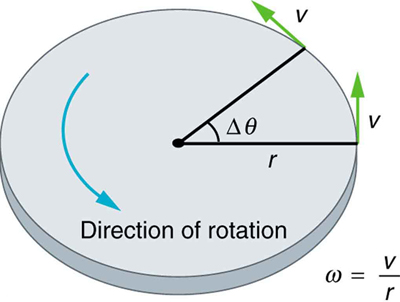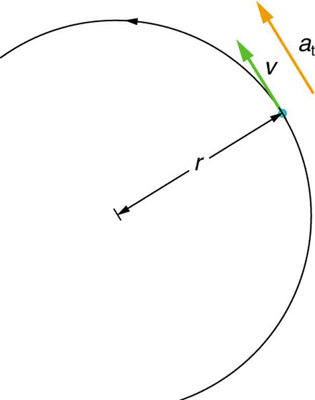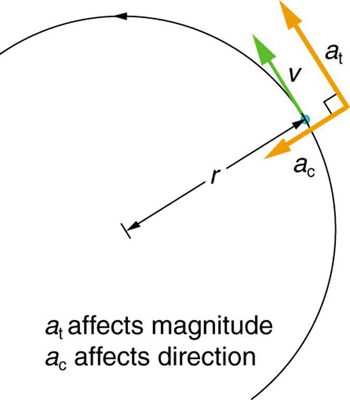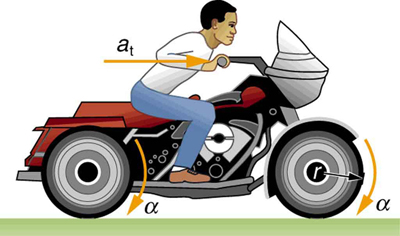
Uniform Circular Motion and Gravitation discussed only uniform circular motion, which is motion in a circle at constant speed and, hence, constant angular velocity. Recall that angular velocity
was defined as the time rate of change of angle
:
where
is the angle of rotation as seen in [link]. The relationship between angular velocity
and linear velocity
was also defined in Rotation Angle and Angular Velocity as
or
where
is the radius of curvature, also seen in [link]. According to the sign convention, the counter clockwise direction is considered as positive direction and clockwise direction as negative

Angular velocity is not constant when a skater pulls in her arms, when a child starts up a merry-go-round from rest, or when a computer’s hard disk slows to a halt when switched off. In all these cases, there is an angular acceleration, in which
changes. The faster the change occurs, the greater the angular acceleration. Angular acceleration
is defined as the rate of change of angular velocity. In equation form, angular acceleration is expressed as follows:
where
is the change in angular velocity and
is the change in time. The units of angular acceleration are
, or
. If
increases, then
is positive. If
decreases, then
is negative.
Suppose a teenager puts her bicycle on its back and starts the rear wheel spinning from rest to a final angular velocity of 250 rpm in 5.00 s. (a) Calculate the angular acceleration in
. (b) If she now slams on the brakes, causing an angular acceleration of
, how long does it take the wheel to stop?
Strategy for (a)
The angular acceleration can be found directly from its definition in
because the final angular velocity and time are given. We see that
is 250 rpm and
is 5.00 s.
Solution for (a)
Entering known information into the definition of angular acceleration, we get
Because
is in revolutions per minute (rpm) and we want the standard units of
for angular acceleration, we need to convert
from rpm to rad/s:
Entering this quantity into the expression for
, we get
Strategy for (b)
In this part, we know the angular acceleration and the initial angular velocity. We can find the stoppage time by using the definition of angular acceleration and solving for
, yielding
Solution for (b)
Here the angular velocity decreases from
(250 rpm) to zero, so that
is
, and
is given to be
. Thus,
Discussion
Note that the angular acceleration as the girl spins the wheel is small and positive; it takes 5 s to produce an appreciable angular velocity. When she hits the brake, the angular acceleration is large and negative. The angular velocity quickly goes to zero. In both cases, the relationships are analogous to what happens with linear motion. For example, there is a large deceleration when you crash into a brick wall—the velocity change is large in a short time interval.
If the bicycle in the preceding example had been on its wheels instead of upside-down, it would first have accelerated along the ground and then come to a stop. This connection between circular motion and linear motion needs to be explored. For example, it would be useful to know how linear and angular acceleration are related. In circular motion, linear acceleration is tangent to the circle at the point of interest, as seen in [link]. Thus, linear acceleration is called tangential acceleration
.

Linear or tangential acceleration refers to changes in the magnitude of velocity but not its direction. We know from Uniform Circular Motion and Gravitation that in circular motion centripetal acceleration,
, refers to changes in the direction of the velocity but not its magnitude. An object undergoing circular motion experiences centripetal acceleration, as seen in [link]. Thus,
and
are perpendicular and independent of one another. Tangential acceleration
is directly related to the angular acceleration
and is linked to an increase or decrease in the velocity, but not its direction.

Now we can find the exact relationship between linear acceleration
and angular acceleration
. Because linear acceleration is proportional to a change in the magnitude of the velocity, it is defined (as it was in One-Dimensional Kinematics) to be
For circular motion, note that
, so that
The radius
is constant for circular motion, and so
. Thus,
By definition,
. Thus,
or
These equations mean that linear acceleration and angular acceleration are directly proportional. The greater the angular acceleration is, the larger the linear (tangential) acceleration is, and vice versa. For example, the greater the angular acceleration of a car’s drive wheels, the greater the acceleration of the car. The radius also matters. For example, the smaller a wheel, the smaller its linear acceleration for a given angular acceleration
.
A powerful motorcycle can accelerate from 0 to 30.0 m/s (about 108 km/h) in 4.20 s. What is the angular acceleration of its 0.320-m-radius wheels? (See [link].)

Strategy
We are given information about the linear velocities of the motorcycle. Thus, we can find its linear acceleration
. Then, the expression
can be used to find the angular acceleration.
Solution
The linear acceleration is
We also know the radius of the wheels. Entering the values for
and
into
, we get
Discussion
Units of radians are dimensionless and appear in any relationship between angular and linear quantities.
So far, we have defined three rotational quantities—
, and
. These quantities are analogous to the translational quantities
, and
. [link] displays rotational quantities, the analogous translational quantities, and the relationships between them.
| Rotational | Translational | Relationship |
|---|---|---|
Sit down with your feet on the ground on a chair that rotates. Lift one of your legs such that it is unbent (straightened out). Using the other leg, begin to rotate yourself by pushing on the ground. Stop using your leg to push the ground but allow the chair to rotate. From the origin where you began, sketch the angle, angular velocity, and angular acceleration of your leg as a function of time in the form of three separate graphs. Estimate the magnitudes of these quantities.
Angular acceleration is a vector, having both magnitude and direction. How do we denote its magnitude and direction? Illustrate with an example.
The magnitude of angular acceleration is
and its most common units are
. The direction of angular acceleration along a fixed axis is denoted by a + or a – sign, just as the direction of linear acceleration in one dimension is denoted by a + or a – sign. For example, consider a gymnast doing a forward flip. Her angular momentum would be parallel to the mat and to her left. The magnitude of her angular acceleration would be proportional to her angular velocity (spin rate) and her moment of inertia about her spin axis.
Join the ladybug in an exploration of rotational motion. Rotate the merry-go-round to change its angle, or choose a constant angular velocity or angular acceleration. Explore how circular motion relates to the bug's x,y position, velocity, and acceleration using vectors or graphs.
.
.
.
, so that
. Thus,
. Thus,
or
Analogies exist between rotational and translational physical quantities. Identify the rotational term analogous to each of the following: acceleration, force, mass, work, translational kinetic energy, linear momentum, impulse.
Explain why centripetal acceleration changes the direction of velocity in circular motion but not its magnitude.
In circular motion, a tangential acceleration can change the magnitude of the velocity but not its direction. Explain your answer.
Suppose a piece of food is on the edge of a rotating microwave oven plate. Does it experience nonzero tangential acceleration, centripetal acceleration, or both when: (a) The plate starts to spin? (b) The plate rotates at constant angular velocity? (c) The plate slows to a halt?
At its peak, a tornado is 60.0 m in diameter and carries 500 km/h winds. What is its angular velocity in revolutions per second?
Integrated Concepts
An ultracentrifuge accelerates from rest to 100,000 rpm in 2.00 min. (a) What is its angular acceleration in
? (b) What is the tangential acceleration of a point 9.50 cm from the axis of rotation? (c) What is the radial acceleration in
and multiples of
of this point at full rpm?
Integrated Concepts
You have a grindstone (a disk) that is 90.0 kg, has a 0.340-m radius, and is turning at 90.0 rpm, and you press a steel axe against it with a radial force of 20.0 N. (a) Assuming the kinetic coefficient of friction between steel and stone is 0.20, calculate the angular acceleration of the grindstone. (b) How many turns will the stone make before coming to rest?
(a)
(b)
Unreasonable Results
You are told that a basketball player spins the ball with an angular acceleration of
. (a) What is the ball’s final angular velocity if the ball starts from rest and the acceleration lasts 2.00 s? (b) What is unreasonable about the result? (c) Which premises are unreasonable or inconsistent?

You can also download for free at http://cnx.org/contents/031da8d3-b525-429c-80cf-6c8ed997733a@11.1
Attribution: